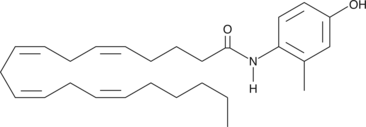Chemicals
Showing 39451–39600 of 41137 results
-
Angiotensin II is a peptide hormone which regulates blood pressure and fluid balance, contributing to hypertension, atherosclerosis, left ventricular hypertrophy, myocardial infarction, and heart failure.{20935} Valsartan is a nonpeptide angiotensin II receptor antagonist of the angiotensin II type 1 (AT1) receptor (IC50 = 2.7 nM).{21001} It is 20,000-fold selective for AT1 over AT2 and, unlike some other AT receptor antagonists, does not alter peroxisome proliferator-activated receptor γ (PPARγ) activity in vitro.{20999} In vivo, valsartan (30 mg/kg) increases cardiac output and reduces left ventricular fibrosis in a model of heart failure with reduced ejection fraction in mice with streptozotocin-induced diabetes.{42153} Formulations containing valsartan have been used in the treatment of hypertension and heart failure.{20999,13660,12999}
Brand:CaymanSKU:-Valsartan-d9 is intended for use as an internal standard for the quantification of valsartan (Item No. 14178) by GC- or LC-MS. Valsartan is a nonpeptide antagonist of the angiotensin II type 1 (AT1) receptor (IC50 = 2.7 nM).{21001} It is 20,000-fold selective for AT1 over AT2 and, unlike some other AT receptor antagonists, does not alter peroxisome proliferator-activated receptor γ (PPARγ) activity in vitro.{20999} In vivo, valsartan (30 mg/kg) increases cardiac output and reduces left ventricular fibrosis in a model of heart failure with reduced ejection fraction in mice with streptozotocin-induced diabetes.{42153} Formulations containing valsartan have been used in the treatment of hypertension and heart failure.{13660,20999,12999}
Brand:CaymanSKU:25226 - 1 mgAvailable on backorder
Vancomycin is a glycopeptide antibiotic identified for its utility in the treatment of gram-positive bacteria, including penicillin-resistant staphylococci.{24881} It acts by binding to bacterial cell wall protein precursors, interfering with continuing protein synthesis.{24882} Vancomycin resistance in staphylococcal species has recently emerged as a clinical issue.{24883}
Brand:CaymanSKU:-Vancomycin is a glycopeptide antibiotic identified for its utility in the treatment of gram-positive bacteria, including penicillin-resistant staphylococci.{24881} It acts by binding to bacterial cell wall protein precursors, interfering with continuing protein synthesis.{24882} Vancomycin resistance in staphylococcal species has recently emerged as a clinical issue.{24883}
Brand:CaymanSKU:-Vancomycin is a glycopeptide antibiotic identified for its utility in the treatment of gram-positive bacteria, including penicillin-resistant staphylococci.{24881} It acts by binding to bacterial cell wall protein precursors, interfering with continuing protein synthesis.{24882} Vancomycin resistance in staphylococcal species has recently emerged as a clinical issue.{24883}
Brand:CaymanSKU:-Vandetanib is a multi-kinase inhibitor that inhibits VEGFR2, VEGFR3, VEGFR1, EGFR, PDGFRβ, Tie-2, and FGFR1 in cell-free assays (IC50s = 40, 110, 1,600, 500, 1,100, 2,500, and 3,600 nM, respectively).{53195,24156} It also binds to 142 additional kinases in a panel of 442 kinases (Kds = 4.6-7,900 nM). Vandetanib (1 and 2.5 µM) induces apoptosis and cell cycle arrest at the G0/G1 phase in GEO colon and OVCAR-3 ovarian cancer cells.{53196} It inhibits proliferation of HAK1-B, KYN-2, and Huh7 hepatocarcinoma cells, as well as human umbilical vein endothelial cells (HUVECs), with IC50 values of 10, 8.1, 9.4, and 7.1 µM, respectively.{53197} Vandetanib (200 mg/kg) increases survival and decreases tumor angiogenesis and VEGFR2 levels in a D54MG glioblastoma mouse xenograft model.{53198} It reduces tumor growth in a variety of mouse xenograft models, including lung, colon, and breast cancer models, when administered at doses of 25, 50, and 100 mg/kg per day.{53195} Formulations containing vandetanib have been used in the treatment of medullary thyroid cancer.
Brand:CaymanSKU:-Vandetanib is a multi-kinase inhibitor that inhibits VEGFR2, VEGFR3, VEGFR1, EGFR, PDGFRβ, Tie-2, and FGFR1 in cell-free assays (IC50s = 40, 110, 1,600, 500, 1,100, 2,500, and 3,600 nM, respectively).{53195,24156} It also binds to 142 additional kinases in a panel of 442 kinases (Kds = 4.6-7,900 nM). Vandetanib (1 and 2.5 µM) induces apoptosis and cell cycle arrest at the G0/G1 phase in GEO colon and OVCAR-3 ovarian cancer cells.{53196} It inhibits proliferation of HAK1-B, KYN-2, and Huh7 hepatocarcinoma cells, as well as human umbilical vein endothelial cells (HUVECs), with IC50 values of 10, 8.1, 9.4, and 7.1 µM, respectively.{53197} Vandetanib (200 mg/kg) increases survival and decreases tumor angiogenesis and VEGFR2 levels in a D54MG glioblastoma mouse xenograft model.{53198} It reduces tumor growth in a variety of mouse xenograft models, including lung, colon, and breast cancer models, when administered at doses of 25, 50, and 100 mg/kg per day.{53195} Formulations containing vandetanib have been used in the treatment of medullary thyroid cancer.
Brand:CaymanSKU:-Vandetanib is a multi-kinase inhibitor that inhibits VEGFR2, VEGFR3, VEGFR1, EGFR, PDGFRβ, Tie-2, and FGFR1 in cell-free assays (IC50s = 40, 110, 1,600, 500, 1,100, 2,500, and 3,600 nM, respectively).{53195,24156} It also binds to 142 additional kinases in a panel of 442 kinases (Kds = 4.6-7,900 nM). Vandetanib (1 and 2.5 µM) induces apoptosis and cell cycle arrest at the G0/G1 phase in GEO colon and OVCAR-3 ovarian cancer cells.{53196} It inhibits proliferation of HAK1-B, KYN-2, and Huh7 hepatocarcinoma cells, as well as human umbilical vein endothelial cells (HUVECs), with IC50 values of 10, 8.1, 9.4, and 7.1 µM, respectively.{53197} Vandetanib (200 mg/kg) increases survival and decreases tumor angiogenesis and VEGFR2 levels in a D54MG glioblastoma mouse xenograft model.{53198} It reduces tumor growth in a variety of mouse xenograft models, including lung, colon, and breast cancer models, when administered at doses of 25, 50, and 100 mg/kg per day.{53195} Formulations containing vandetanib have been used in the treatment of medullary thyroid cancer.
Brand:CaymanSKU:-Vandetanib is a multi-kinase inhibitor that inhibits VEGFR2, VEGFR3, VEGFR1, EGFR, PDGFRβ, Tie-2, and FGFR1 in cell-free assays (IC50s = 40, 110, 1,600, 500, 1,100, 2,500, and 3,600 nM, respectively).{53195,24156} It also binds to 142 additional kinases in a panel of 442 kinases (Kds = 4.6-7,900 nM). Vandetanib (1 and 2.5 µM) induces apoptosis and cell cycle arrest at the G0/G1 phase in GEO colon and OVCAR-3 ovarian cancer cells.{53196} It inhibits proliferation of HAK1-B, KYN-2, and Huh7 hepatocarcinoma cells, as well as human umbilical vein endothelial cells (HUVECs), with IC50 values of 10, 8.1, 9.4, and 7.1 µM, respectively.{53197} Vandetanib (200 mg/kg) increases survival and decreases tumor angiogenesis and VEGFR2 levels in a D54MG glioblastoma mouse xenograft model.{53198} It reduces tumor growth in a variety of mouse xenograft models, including lung, colon, and breast cancer models, when administered at doses of 25, 50, and 100 mg/kg per day.{53195} Formulations containing vandetanib have been used in the treatment of medullary thyroid cancer.
Brand:CaymanSKU:-Vandetanib-d6 is intended for use as an internal standard for the quantification of vandetanib (Item No. 14706) by GC- or LC-MS. Vandetanib is a multi-kinase inhibitor that inhibits VEGFR2, VEGFR3, VEGFR1, EGFR, PDGFRβ, Tie-2, and FGFR1 in cell-free assays (IC50s = 40, 110, 1,600, 500, 1,100, 2,500, and 3,600 nM, respectively).{53195,24156} It also binds to 142 additional kinases in a panel of 442 kinases (Kds = 4.6-7,900 nM). Vandetanib (1 and 2.5 µM) induces apoptosis and cell cycle arrest at the G0/G1 phase in GEO colon and OVCAR-3 ovarian cancer cells.{53196} It inhibits proliferation of HAK1-B, KYN-2, and Huh7 hepatocarcinoma cells, as well as human umbilical vein endothelial cells (HUVECs), with IC50 values of 10, 8.1, 9.4, and 7.1 µM, respectively.{53197} Vandetanib (200 mg/kg) increases survival and decreases tumor angiogenesis and VEGFR2 levels in a D54MG glioblastoma mouse xenograft model.{53198} It reduces tumor growth in a variety of mouse xenograft models, including lung, colon, and breast cancer models, when administered at doses of 25, 50, and 100 mg/kg per day.{53195} Formulations containing vandetanib have been used in the treatment of medullary thyroid cancer.
Brand:CaymanSKU:28710 - 1 mgAvailable on backorder
Vandetanib-d6 is intended for use as an internal standard for the quantification of vandetanib (Item No. 14706) by GC- or LC-MS. Vandetanib is a multi-kinase inhibitor that inhibits VEGFR2, VEGFR3, VEGFR1, EGFR, PDGFRβ, Tie-2, and FGFR1 in cell-free assays (IC50s = 40, 110, 1,600, 500, 1,100, 2,500, and 3,600 nM, respectively).{53195,24156} It also binds to 142 additional kinases in a panel of 442 kinases (Kds = 4.6-7,900 nM). Vandetanib (1 and 2.5 µM) induces apoptosis and cell cycle arrest at the G0/G1 phase in GEO colon and OVCAR-3 ovarian cancer cells.{53196} It inhibits proliferation of HAK1-B, KYN-2, and Huh7 hepatocarcinoma cells, as well as human umbilical vein endothelial cells (HUVECs), with IC50 values of 10, 8.1, 9.4, and 7.1 µM, respectively.{53197} Vandetanib (200 mg/kg) increases survival and decreases tumor angiogenesis and VEGFR2 levels in a D54MG glioblastoma mouse xenograft model.{53198} It reduces tumor growth in a variety of mouse xenograft models, including lung, colon, and breast cancer models, when administered at doses of 25, 50, and 100 mg/kg per day.{53195} Formulations containing vandetanib have been used in the treatment of medullary thyroid cancer.
Brand:CaymanSKU:28710 - 5 mgAvailable on backorder
Vandetanib-d6 is intended for use as an internal standard for the quantification of vandetanib (Item No. 14706) by GC- or LC-MS. Vandetanib is a multi-kinase inhibitor that inhibits VEGFR2, VEGFR3, VEGFR1, EGFR, PDGFRβ, Tie-2, and FGFR1 in cell-free assays (IC50s = 40, 110, 1,600, 500, 1,100, 2,500, and 3,600 nM, respectively).{53195,24156} It also binds to 142 additional kinases in a panel of 442 kinases (Kds = 4.6-7,900 nM). Vandetanib (1 and 2.5 µM) induces apoptosis and cell cycle arrest at the G0/G1 phase in GEO colon and OVCAR-3 ovarian cancer cells.{53196} It inhibits proliferation of HAK1-B, KYN-2, and Huh7 hepatocarcinoma cells, as well as human umbilical vein endothelial cells (HUVECs), with IC50 values of 10, 8.1, 9.4, and 7.1 µM, respectively.{53197} Vandetanib (200 mg/kg) increases survival and decreases tumor angiogenesis and VEGFR2 levels in a D54MG glioblastoma mouse xenograft model.{53198} It reduces tumor growth in a variety of mouse xenograft models, including lung, colon, and breast cancer models, when administered at doses of 25, 50, and 100 mg/kg per day.{53195} Formulations containing vandetanib have been used in the treatment of medullary thyroid cancer.
Brand:CaymanSKU:28710 - 500 µgAvailable on backorder
Vanillic Acid 4-β-D-glucopyranoside can be isolated from the fruits of C. annuum as well as the leaves of various additional plants. It belongs to a class of compounds known as hydrolyzable tannins and can be phytotoxic against different species.{32638}
Brand:CaymanSKU:19759 -Available on backorder
Vanillic Acid 4-β-D-glucopyranoside can be isolated from the fruits of C. annuum as well as the leaves of various additional plants. It belongs to a class of compounds known as hydrolyzable tannins and can be phytotoxic against different species.{32638}
Brand:CaymanSKU:19759 -Available on backorder
Vanillic Acid 4-β-D-glucopyranoside can be isolated from the fruits of C. annuum as well as the leaves of various additional plants. It belongs to a class of compounds known as hydrolyzable tannins and can be phytotoxic against different species.{32638}
Brand:CaymanSKU:19759 -Available on backorder
Vanillic Acid 4-β-D-glucopyranoside can be isolated from the fruits of C. annuum as well as the leaves of various additional plants. It belongs to a class of compounds known as hydrolyzable tannins and can be phytotoxic against different species.{32638}
Brand:CaymanSKU:19759 -Available on backorder
Vapendavir is a capsid-binding antiviral agent.{52755,52756} It binds to a pocket in the human rhinovirus (HRV) strain HRV2 VP1 capsid protein and inhibits the cytopathic effects of HRV2 and HRV14 in HeLa Ohio cells (EC50s = 1 and 5 ng/ml, respectively), as well as in a panel of 39 HRV clinical isolates (median EC50 = 7.3 ng/ml).{52755} Vapendavir inhibits replication in a panel of 21 enterovirus 71 (EV71) isolates with an average EC50 value of 0.7 μM.{52756}
Brand:CaymanSKU:30546 - 1 mgAvailable on backorder
Vapendavir is a capsid-binding antiviral agent.{52755,52756} It binds to a pocket in the human rhinovirus (HRV) strain HRV2 VP1 capsid protein and inhibits the cytopathic effects of HRV2 and HRV14 in HeLa Ohio cells (EC50s = 1 and 5 ng/ml, respectively), as well as in a panel of 39 HRV clinical isolates (median EC50 = 7.3 ng/ml).{52755} Vapendavir inhibits replication in a panel of 21 enterovirus 71 (EV71) isolates with an average EC50 value of 0.7 μM.{52756}
Brand:CaymanSKU:30546 - 10 mgAvailable on backorder
Vapendavir is a capsid-binding antiviral agent.{52755,52756} It binds to a pocket in the human rhinovirus (HRV) strain HRV2 VP1 capsid protein and inhibits the cytopathic effects of HRV2 and HRV14 in HeLa Ohio cells (EC50s = 1 and 5 ng/ml, respectively), as well as in a panel of 39 HRV clinical isolates (median EC50 = 7.3 ng/ml).{52755} Vapendavir inhibits replication in a panel of 21 enterovirus 71 (EV71) isolates with an average EC50 value of 0.7 μM.{52756}
Brand:CaymanSKU:30546 - 25 mgAvailable on backorder
Vapendavir is a capsid-binding antiviral agent.{52755,52756} It binds to a pocket in the human rhinovirus (HRV) strain HRV2 VP1 capsid protein and inhibits the cytopathic effects of HRV2 and HRV14 in HeLa Ohio cells (EC50s = 1 and 5 ng/ml, respectively), as well as in a panel of 39 HRV clinical isolates (median EC50 = 7.3 ng/ml).{52755} Vapendavir inhibits replication in a panel of 21 enterovirus 71 (EV71) isolates with an average EC50 value of 0.7 μM.{52756}
Brand:CaymanSKU:30546 - 5 mgAvailable on backorder
Vardenafil is a potent inhibitor of phosphodiesterase 5 (PDE5; IC50s = 0.2-1.2 nM) and PDE6 (IC50 = 2 nM).{24530,24529,24568} It is selective for PDE5 and PDE6 over PDE1 and PDE11 (IC50s = 230 and 130 nM, respectively). Vardenafil (4 mg/kg per day for three weeks) improves erectile function in a rat model of acute arteriogenic erectile dysfunction by increasing intracavernous pressure and mean arterial pressure, and this effect persists for at least two weeks following the end of treatment.{41771} Chronic vardenafil administration at a dose of 2 mg/kg for five weeks in subordinate mice reduces the latency to mount and increases the frequency of mounting behavior.{41772} Formulations containing vardenafil have been used in the treatment of erectile dysfunction.
Brand:CaymanSKU:-Vardenafil is a potent inhibitor of phosphodiesterase 5 (PDE5; IC50s = 0.2-1.2 nM) and PDE6 (IC50 = 2 nM).{24530,24529,24568} It is selective for PDE5 and PDE6 over PDE1 and PDE11 (IC50s = 230 and 130 nM, respectively). Vardenafil (4 mg/kg per day for three weeks) improves erectile function in a rat model of acute arteriogenic erectile dysfunction by increasing intracavernous pressure and mean arterial pressure, and this effect persists for at least two weeks following the end of treatment.{41771} Chronic vardenafil administration at a dose of 2 mg/kg for five weeks in subordinate mice reduces the latency to mount and increases the frequency of mounting behavior.{41772} Formulations containing vardenafil have been used in the treatment of erectile dysfunction.
Brand:CaymanSKU:-Vardenafil is a potent inhibitor of phosphodiesterase 5 (PDE5; IC50s = 0.2-1.2 nM) and PDE6 (IC50 = 2 nM).{24530,24529,24568} It is selective for PDE5 and PDE6 over PDE1 and PDE11 (IC50s = 230 and 130 nM, respectively). Vardenafil (4 mg/kg per day for three weeks) improves erectile function in a rat model of acute arteriogenic erectile dysfunction by increasing intracavernous pressure and mean arterial pressure, and this effect persists for at least two weeks following the end of treatment.{41771} Chronic vardenafil administration at a dose of 2 mg/kg for five weeks in subordinate mice reduces the latency to mount and increases the frequency of mounting behavior.{41772} Formulations containing vardenafil have been used in the treatment of erectile dysfunction.
Brand:CaymanSKU:-Vardenafil is a potent inhibitor of phosphodiesterase 5 (PDE5; IC50s = 0.2-1.2 nM) and PDE6 (IC50 = 2 nM).{24530,24529,24568} It is selective for PDE5 and PDE6 over PDE1 and PDE11 (IC50s = 230 and 130 nM, respectively). Vardenafil (4 mg/kg per day for three weeks) improves erectile function in a rat model of acute arteriogenic erectile dysfunction by increasing intracavernous pressure and mean arterial pressure, and this effect persists for at least two weeks following the end of treatment.{41771} Chronic vardenafil administration at a dose of 2 mg/kg for five weeks in subordinate mice reduces the latency to mount and increases the frequency of mounting behavior.{41772} Formulations containing vardenafil have been used in the treatment of erectile dysfunction.
Brand:CaymanSKU:-Vardenafil-d5 is intended for use as an internal standard for the quantification of vardenafil (Item No. 14930) by GC- or LC-MS. Vardenafil is a potent inhibitor of phosphodiesterase 5 (PDE5; IC50s = 0.2-1.2 nM) and PDE6 (IC50 = 2 nM).{24530,24529,24568} It is selective for PDE5 and PDE6 over PDE1 and PDE11 (IC50s = 230 and 130 nM, respectively). Vardenafil (4 mg/kg per day for three weeks) improves erectile function in a rat model of acute arteriogenic erectile dysfunction by increasing intracavernous pressure and mean arterial pressure, and this effect persists for at least two weeks following the end of treatment.{41771} Chronic vardenafil administration at a dose of 2 mg/kg for five weeks to subordinate mice reduces the latency to mount and increases the frequency of mounting behavior.{41772} Formulations containing vardenafil have been used in the treatment of erectile dysfunction.
Brand:CaymanSKU:25225 - 1 mgAvailable on backorder
Vardenafil-d5 is intended for use as an internal standard for the quantification of vardenafil (Item No. 14930) by GC- or LC-MS. Vardenafil is a potent inhibitor of phosphodiesterase 5 (PDE5; IC50s = 0.2-1.2 nM) and PDE6 (IC50 = 2 nM).{24530,24529,24568} It is selective for PDE5 and PDE6 over PDE1 and PDE11 (IC50s = 230 and 130 nM, respectively). Vardenafil (4 mg/kg per day for three weeks) improves erectile function in a rat model of acute arteriogenic erectile dysfunction by increasing intracavernous pressure and mean arterial pressure, and this effect persists for at least two weeks following the end of treatment.{41771} Chronic vardenafil administration at a dose of 2 mg/kg for five weeks to subordinate mice reduces the latency to mount and increases the frequency of mounting behavior.{41772} Formulations containing vardenafil have been used in the treatment of erectile dysfunction.
Brand:CaymanSKU:25225 - 500 µgAvailable on backorder
Varenicline is a full agonist of α7 subunit-containing neuronal nicotinic acetylcholine receptors (nAChRs; EC50 = 18 µM) and a partial agonist of α4β2 subunit-containing nAChRs (EC50 = 2.3 µM).{22776} Formulations containing varenicline have been used as aids in smoking cessation.
Brand:CaymanSKU:-Varenicline is a full agonist of α7 subunit-containing neuronal nicotinic acetylcholine receptors (nAChRs; EC50 = 18 µM) and a partial agonist of α4β2 subunit-containing nAChRs (EC50 = 2.3 µM).{22776} Formulations containing varenicline have been used as aids in smoking cessation.
Brand:CaymanSKU:-Varenicline is a full agonist of α7 subunit-containing neuronal nicotinic acetylcholine receptors (nAChRs; EC50 = 18 µM) and a partial agonist of α4β2 subunit-containing nAChRs (EC50 = 2.3 µM).{22776} Formulations containing varenicline have been used as aids in smoking cessation.
Brand:CaymanSKU:-Varenicline is a full agonist of α7 subunit-containing neuronal nicotinic acetylcholine receptors (nAChRs; EC50 = 18 µM) and a partial agonist of α4β2 subunit-containing nAChRs (EC50 = 2.3 µM).{22776} Formulations containing varenicline have been used as aids in smoking cessation.
Brand:CaymanSKU:-Varenicline-d4 is intended for use as an internal standard for the quantification of varenicline (Item No. 15030) by GC- or LC-MS. Varenicline is a full agonist of α7 subunit-containing neuronal nicotinic acetylcholine receptors (nAChRs; EC50 = 18 µM) and a partial agonist of α4β2 subunit-containing nAChRs (EC50 = 2.3 µM).{22776} Formulations containing varenicline have been used as aids in smoking cessation.
Brand:CaymanSKU:26102 - 1 mgAvailable on backorder
Varenicline-d4 is intended for use as an internal standard for the quantification of varenicline (Item No. 15030) by GC- or LC-MS. Varenicline is a full agonist of α7 subunit-containing neuronal nicotinic acetylcholine receptors (nAChRs; EC50 = 18 µM) and a partial agonist of α4β2 subunit-containing nAChRs (EC50 = 2.3 µM).{22776} Formulations containing varenicline have been used as aids in smoking cessation.
Brand:CaymanSKU:26102 - 500 µgAvailable on backorder
Brand:CaymanSKU:29064 - 1 mgAvailable on backorder
Varinolic acid (Item No. 26283) is an analytical reference standard categorized as an intermediate in the phytocannabinoid biosynthetic pathway.{51050,51051} It is a precursor in the synthesis of cannabidivarin (CBDV; Item Nos. 20165 | 9001574), cannabigerovarin (CBGV; Item No. 9002437), and cannabivarin (CBV; Item No. 21664). This product is intended for research and forensic applications.
Brand:CaymanSKU:26283 - 1 mgAvailable on backorder
Varinolic acid (Item No. 26283) is an analytical reference standard categorized as an intermediate in the phytocannabinoid biosynthetic pathway.{51050,51051} It is a precursor in the synthesis of cannabidivarin (CBDV; Item Nos. 20165 | 9001574), cannabigerovarin (CBGV; Item No. 9002437), and cannabivarin (CBV; Item No. 21664). This product is intended for research and forensic applications.
Brand:CaymanSKU:26283 - 5 mgAvailable on backorder
Varlitinib is an inhibitor of EGFR and HER2 (IC50s = 7 and 2 nM, respectively).{48649,48650} It inhibits cell proliferation (IC50s = In vivo, varlitinib (100 mg/kg) inhibits phosphorylation of EGFR and ERK and reduces tumor weight in an MDA-MB-468 mouse xenograft model.
Brand:CaymanSKU:27651 - 1 mgAvailable on backorder
Varlitinib is an inhibitor of EGFR and HER2 (IC50s = 7 and 2 nM, respectively).{48649,48650} It inhibits cell proliferation (IC50s = In vivo, varlitinib (100 mg/kg) inhibits phosphorylation of EGFR and ERK and reduces tumor weight in an MDA-MB-468 mouse xenograft model.
Brand:CaymanSKU:27651 - 10 mgAvailable on backorder
Varlitinib is an inhibitor of EGFR and HER2 (IC50s = 7 and 2 nM, respectively).{48649,48650} It inhibits cell proliferation (IC50s = In vivo, varlitinib (100 mg/kg) inhibits phosphorylation of EGFR and ERK and reduces tumor weight in an MDA-MB-468 mouse xenograft model.
Brand:CaymanSKU:27651 - 25 mgAvailable on backorder
Varlitinib is an inhibitor of EGFR and HER2 (IC50s = 7 and 2 nM, respectively).{48649,48650} It inhibits cell proliferation (IC50s = In vivo, varlitinib (100 mg/kg) inhibits phosphorylation of EGFR and ERK and reduces tumor weight in an MDA-MB-468 mouse xenograft model.
Brand:CaymanSKU:27651 - 5 mgAvailable on backorder
VAS2870 is a selective inhibitor of the NADPH oxidases.{34568,34569,34570,34593} Pre-incubation of rat vascular smooth muscle cells with VAS2870 abolishes platelet-derived growth factor-dependent chemotaxis without affecting cell cycle progression (IC50 = 10 µM).{34568} At low (2.8 mM), but not high (16.7 mM), concentrations of glucose, treatment with VAS2870 (20 µM) increases glucose-stimulated insulin secretion of rat pancreatic islets by 70%.{34575} It significantly reduces production of reactive oxygen species in mouse brain, rat vascular smooth muscle culture, and human umbilical vein endothelial cells.{34568,34571,34572} Treatment with VAS2870 pre- or post-ischemia is neuroprotective in mouse brain.{34571} VAS2870 inhibits vasculogenesis of mouse embryonic stem cell cultures and inhibits cell proliferation of rat hepatoma cells.{34573,34574}
Brand:CaymanSKU:-Available on backorder
VAS2870 is a selective inhibitor of the NADPH oxidases.{34568,34569,34570,34593} Pre-incubation of rat vascular smooth muscle cells with VAS2870 abolishes platelet-derived growth factor-dependent chemotaxis without affecting cell cycle progression (IC50 = 10 µM).{34568} At low (2.8 mM), but not high (16.7 mM), concentrations of glucose, treatment with VAS2870 (20 µM) increases glucose-stimulated insulin secretion of rat pancreatic islets by 70%.{34575} It significantly reduces production of reactive oxygen species in mouse brain, rat vascular smooth muscle culture, and human umbilical vein endothelial cells.{34568,34571,34572} Treatment with VAS2870 pre- or post-ischemia is neuroprotective in mouse brain.{34571} VAS2870 inhibits vasculogenesis of mouse embryonic stem cell cultures and inhibits cell proliferation of rat hepatoma cells.{34573,34574}
Brand:CaymanSKU:-Available on backorder
VAS2870 is a selective inhibitor of the NADPH oxidases.{34568,34569,34570,34593} Pre-incubation of rat vascular smooth muscle cells with VAS2870 abolishes platelet-derived growth factor-dependent chemotaxis without affecting cell cycle progression (IC50 = 10 µM).{34568} At low (2.8 mM), but not high (16.7 mM), concentrations of glucose, treatment with VAS2870 (20 µM) increases glucose-stimulated insulin secretion of rat pancreatic islets by 70%.{34575} It significantly reduces production of reactive oxygen species in mouse brain, rat vascular smooth muscle culture, and human umbilical vein endothelial cells.{34568,34571,34572} Treatment with VAS2870 pre- or post-ischemia is neuroprotective in mouse brain.{34571} VAS2870 inhibits vasculogenesis of mouse embryonic stem cell cultures and inhibits cell proliferation of rat hepatoma cells.{34573,34574}
Brand:CaymanSKU:-Available on backorder
VAS2870 is a selective inhibitor of the NADPH oxidases.{34568,34569,34570,34593} Pre-incubation of rat vascular smooth muscle cells with VAS2870 abolishes platelet-derived growth factor-dependent chemotaxis without affecting cell cycle progression (IC50 = 10 µM).{34568} At low (2.8 mM), but not high (16.7 mM), concentrations of glucose, treatment with VAS2870 (20 µM) increases glucose-stimulated insulin secretion of rat pancreatic islets by 70%.{34575} It significantly reduces production of reactive oxygen species in mouse brain, rat vascular smooth muscle culture, and human umbilical vein endothelial cells.{34568,34571,34572} Treatment with VAS2870 pre- or post-ischemia is neuroprotective in mouse brain.{34571} VAS2870 inhibits vasculogenesis of mouse embryonic stem cell cultures and inhibits cell proliferation of rat hepatoma cells.{34573,34574}
Brand:CaymanSKU:-Available on backorder
Vasicine is an alkaloid isolated from A. vasica with diverse biological activities.{36452,36453,36454} In vivo, vasicine (0.2 mg/kg) reduces lipid peroxidation, increases activity of the antioxidases superoxide dismutase (SOD), catalase (CAT), and glutathione (GSH) peroxidase (Gpx), and increases levels of GSH in lung in a rat model of toxin-induced asthma.{36452} It reduces ammonia- and capsaicin-induced coughing frequency in mice as well as citric acid-induced coughing frequency in guinea pigs.{36453} Vasicine (5-45 mg/kg) increases phenol red secretion, a marker of expectorant activity, in mice. It also extends pre-convulsive time, a marker of bronchodilation, in guinea pigs. Vasicine also stimulates uterine contractions in rats and mice.{36454}
Brand:CaymanSKU:11760 - 1 mgAvailable on backorder
Vasicine is an alkaloid isolated from A. vasica with diverse biological activities.{36452,36453,36454} In vivo, vasicine (0.2 mg/kg) reduces lipid peroxidation, increases activity of the antioxidases superoxide dismutase (SOD), catalase (CAT), and glutathione (GSH) peroxidase (Gpx), and increases levels of GSH in lung in a rat model of toxin-induced asthma.{36452} It reduces ammonia- and capsaicin-induced coughing frequency in mice as well as citric acid-induced coughing frequency in guinea pigs.{36453} Vasicine (5-45 mg/kg) increases phenol red secretion, a marker of expectorant activity, in mice. It also extends pre-convulsive time, a marker of bronchodilation, in guinea pigs. Vasicine also stimulates uterine contractions in rats and mice.{36454}
Brand:CaymanSKU:11760 - 10 mgAvailable on backorder
Vasicine is an alkaloid isolated from A. vasica with diverse biological activities.{36452,36453,36454} In vivo, vasicine (0.2 mg/kg) reduces lipid peroxidation, increases activity of the antioxidases superoxide dismutase (SOD), catalase (CAT), and glutathione (GSH) peroxidase (Gpx), and increases levels of GSH in lung in a rat model of toxin-induced asthma.{36452} It reduces ammonia- and capsaicin-induced coughing frequency in mice as well as citric acid-induced coughing frequency in guinea pigs.{36453} Vasicine (5-45 mg/kg) increases phenol red secretion, a marker of expectorant activity, in mice. It also extends pre-convulsive time, a marker of bronchodilation, in guinea pigs. Vasicine also stimulates uterine contractions in rats and mice.{36454}
Brand:CaymanSKU:11760 - 5 mgAvailable on backorder
Vasicinone is a quinazoline alkaloid that can be isolated from A. vasica leaves and demonstrates bronchodilatory activity.{32674} It also is reported to possess antioxidant activity in nitric oxide and ABTS radical scavenging assays.{32675}
Brand:CaymanSKU:11761 - 1 mgAvailable on backorder
Vasicinone is a quinazoline alkaloid that can be isolated from A. vasica leaves and demonstrates bronchodilatory activity.{32674} It also is reported to possess antioxidant activity in nitric oxide and ABTS radical scavenging assays.{32675}
Brand:CaymanSKU:11761 - 10 mgAvailable on backorder
Vasicinone is a quinazoline alkaloid that can be isolated from A. vasica leaves and demonstrates bronchodilatory activity.{32674} It also is reported to possess antioxidant activity in nitric oxide and ABTS radical scavenging assays.{32675}
Brand:CaymanSKU:11761 - 5 mgAvailable on backorder
Vatalanib is an antagonist of the VEGF receptors, inhibiting the receptor tyrosine kinase activities of VEGFR1 (Flt1), VEGFR2 (KDR), and VEGFR3 (Flt4) with IC50 values of 77, 37, and 190 nM, respectively.{24346,24345} It less potently inhibits PDGF and c-Kit (IC50 = 600 and 700 nM) and has no effect on a large panel of additional kinases.{24346,24344,24345} Vatalanib completely blocks retinal neovascularization in oxygen-induced ischemic retinopathy in mice, suggesting its use in diabetic retinopathy and other diseases featuring aberrant vascular development.{18281,24343}
Brand:CaymanSKU:-Vatalanib is an antagonist of the VEGF receptors, inhibiting the receptor tyrosine kinase activities of VEGFR1 (Flt1), VEGFR2 (KDR), and VEGFR3 (Flt4) with IC50 values of 77, 37, and 190 nM, respectively.{24346,24345} It less potently inhibits PDGF and c-Kit (IC50 = 600 and 700 nM) and has no effect on a large panel of additional kinases.{24346,24344,24345} Vatalanib completely blocks retinal neovascularization in oxygen-induced ischemic retinopathy in mice, suggesting its use in diabetic retinopathy and other diseases featuring aberrant vascular development.{18281,24343}
Brand:CaymanSKU:-Vatalanib is an antagonist of the VEGF receptors, inhibiting the receptor tyrosine kinase activities of VEGFR1 (Flt1), VEGFR2 (KDR), and VEGFR3 (Flt4) with IC50 values of 77, 37, and 190 nM, respectively.{24346,24345} It less potently inhibits PDGF and c-Kit (IC50 = 600 and 700 nM) and has no effect on a large panel of additional kinases.{24346,24344,24345} Vatalanib completely blocks retinal neovascularization in oxygen-induced ischemic retinopathy in mice, suggesting its use in diabetic retinopathy and other diseases featuring aberrant vascular development.{18281,24343}
Brand:CaymanSKU:-Vatalanib is an antagonist of the VEGF receptors, inhibiting the receptor tyrosine kinase activities of VEGFR1 (Flt1), VEGFR2 (KDR), and VEGFR3 (Flt4) with IC50 values of 77, 37, and 190 nM, respectively.{24346,24345} It less potently inhibits PDGF and c-Kit (IC50 = 600 and 700 nM) and has no effect on a large panel of additional kinases.{24346,24344,24345} Vatalanib completely blocks retinal neovascularization in oxygen-induced ischemic retinopathy in mice, suggesting its use in diabetic retinopathy and other diseases featuring aberrant vascular development.{18281,24343}
Brand:CaymanSKU:-Vatiquinone is a metabolite of α-tocotrienol (Item No. 10008377) that has antioxidant and ferroptosis inhibitory activity.{56151,56152} It inhibits decreases in cell viability induced by the γ-glutamylcysteine synthetase inhibitor L-buthionine-(S,R)-sulfoximine (BSO; Item No. 14484) in primary fibroblasts isolated from patients with the mitochondrial diseases Friedreich’s ataxia or Leigh syndrome (EC50s = 24 and 30 nM, respectively).{56151} Vatiquinone inhibits cell death and lipid peroxidation induced by the glutathione peroxidase 4 (GPX4) inhibitor RSL3 in primary fibroblasts isolated from patients with the mitochondrial encephalopathic epilepsy disease pontocerebellar hypoplasia type 6 (PCH6; EC50s = 17.3-21.8 and 33.1-57.6 nM, respectively).{56152}
Brand:CaymanSKU:26819 - 1 mgAvailable on backorder
Vatiquinone is a metabolite of α-tocotrienol (Item No. 10008377) that has antioxidant and ferroptosis inhibitory activity.{56151,56152} It inhibits decreases in cell viability induced by the γ-glutamylcysteine synthetase inhibitor L-buthionine-(S,R)-sulfoximine (BSO; Item No. 14484) in primary fibroblasts isolated from patients with the mitochondrial diseases Friedreich’s ataxia or Leigh syndrome (EC50s = 24 and 30 nM, respectively).{56151} Vatiquinone inhibits cell death and lipid peroxidation induced by the glutathione peroxidase 4 (GPX4) inhibitor RSL3 in primary fibroblasts isolated from patients with the mitochondrial encephalopathic epilepsy disease pontocerebellar hypoplasia type 6 (PCH6; EC50s = 17.3-21.8 and 33.1-57.6 nM, respectively).{56152}
Brand:CaymanSKU:26819 - 10 mgAvailable on backorder
Vatiquinone is a metabolite of α-tocotrienol (Item No. 10008377) that has antioxidant and ferroptosis inhibitory activity.{56151,56152} It inhibits decreases in cell viability induced by the γ-glutamylcysteine synthetase inhibitor L-buthionine-(S,R)-sulfoximine (BSO; Item No. 14484) in primary fibroblasts isolated from patients with the mitochondrial diseases Friedreich’s ataxia or Leigh syndrome (EC50s = 24 and 30 nM, respectively).{56151} Vatiquinone inhibits cell death and lipid peroxidation induced by the glutathione peroxidase 4 (GPX4) inhibitor RSL3 in primary fibroblasts isolated from patients with the mitochondrial encephalopathic epilepsy disease pontocerebellar hypoplasia type 6 (PCH6; EC50s = 17.3-21.8 and 33.1-57.6 nM, respectively).{56152}
Brand:CaymanSKU:26819 - 25 mgAvailable on backorder
Vatiquinone is a metabolite of α-tocotrienol (Item No. 10008377) that has antioxidant and ferroptosis inhibitory activity.{56151,56152} It inhibits decreases in cell viability induced by the γ-glutamylcysteine synthetase inhibitor L-buthionine-(S,R)-sulfoximine (BSO; Item No. 14484) in primary fibroblasts isolated from patients with the mitochondrial diseases Friedreich’s ataxia or Leigh syndrome (EC50s = 24 and 30 nM, respectively).{56151} Vatiquinone inhibits cell death and lipid peroxidation induced by the glutathione peroxidase 4 (GPX4) inhibitor RSL3 in primary fibroblasts isolated from patients with the mitochondrial encephalopathic epilepsy disease pontocerebellar hypoplasia type 6 (PCH6; EC50s = 17.3-21.8 and 33.1-57.6 nM, respectively).{56152}
Brand:CaymanSKU:26819 - 5 mgAvailable on backorder
VBIT-12 is a voltage-dependent anion channel 1 (VDAC1) inhibitor.{57236} It inhibits VDAC1 conductance in synthetic lipid membranes containing purified rat VDAC1 when used at concentrations ranging from 20 to 100 µM.
Brand:CaymanSKU:31445 - 1 mgAvailable on backorder
VBIT-12 is a voltage-dependent anion channel 1 (VDAC1) inhibitor.{57236} It inhibits VDAC1 conductance in synthetic lipid membranes containing purified rat VDAC1 when used at concentrations ranging from 20 to 100 µM.
Brand:CaymanSKU:31445 - 10 mgAvailable on backorder
VBIT-12 is a voltage-dependent anion channel 1 (VDAC1) inhibitor.{57236} It inhibits VDAC1 conductance in synthetic lipid membranes containing purified rat VDAC1 when used at concentrations ranging from 20 to 100 µM.
Brand:CaymanSKU:31445 - 25 mgAvailable on backorder
VBIT-12 is a voltage-dependent anion channel 1 (VDAC1) inhibitor.{57236} It inhibits VDAC1 conductance in synthetic lipid membranes containing purified rat VDAC1 when used at concentrations ranging from 20 to 100 µM.
Brand:CaymanSKU:31445 - 5 mgAvailable on backorder
VCP171 is a positive allosteric modulator of adenosine A1 receptors (EC50 = 15.8 μM in a kinetic assay measuring agonist dissociation).{61017}. It reduces AMPA receptor-mediated evoked excitatory postsynaptic currents (eEPSCs) in lamina I and lamina II neurons in a rat model of neuropathic pain (EC50s = 1.995 and 0.251 μM, respectively) to a greater extent than in sham control animals (EC50s = 2.512 and 0.631 μM, respectively).{45812}
Brand:CaymanSKU:30309 - 1 mgAvailable on backorder
VCP171 is a positive allosteric modulator of adenosine A1 receptors (EC50 = 15.8 μM in a kinetic assay measuring agonist dissociation).{61017}. It reduces AMPA receptor-mediated evoked excitatory postsynaptic currents (eEPSCs) in lamina I and lamina II neurons in a rat model of neuropathic pain (EC50s = 1.995 and 0.251 μM, respectively) to a greater extent than in sham control animals (EC50s = 2.512 and 0.631 μM, respectively).{45812}
Brand:CaymanSKU:30309 - 10 mgAvailable on backorder
VCP171 is a positive allosteric modulator of adenosine A1 receptors (EC50 = 15.8 μM in a kinetic assay measuring agonist dissociation).{61017}. It reduces AMPA receptor-mediated evoked excitatory postsynaptic currents (eEPSCs) in lamina I and lamina II neurons in a rat model of neuropathic pain (EC50s = 1.995 and 0.251 μM, respectively) to a greater extent than in sham control animals (EC50s = 2.512 and 0.631 μM, respectively).{45812}
Brand:CaymanSKU:30309 - 25 mgAvailable on backorder
VCP171 is a positive allosteric modulator of adenosine A1 receptors (EC50 = 15.8 μM in a kinetic assay measuring agonist dissociation).{61017}. It reduces AMPA receptor-mediated evoked excitatory postsynaptic currents (eEPSCs) in lamina I and lamina II neurons in a rat model of neuropathic pain (EC50s = 1.995 and 0.251 μM, respectively) to a greater extent than in sham control animals (EC50s = 2.512 and 0.631 μM, respectively).{45812}
Brand:CaymanSKU:30309 - 5 mgAvailable on backorder
Numerous analogs of arachidonoyl ethanolamide (AEA) potentiate its biological activity. This potentiation is ascribed either to inhibition of AEA reuptake into neurons, or inhibition of fatty amide acyl hydrolase (FAAH) within the neurons.{10254,10647} VDM11 is an AEA transport inhibitor with essentially no activity on either the central cannabinoid receptor (CB1), peripheral cannabinoid receptor (CB2), or the vanilloid receptor 1 (VR1).{9577} However, VDM11 inhibits FAAH and monoacylglycerol lipase (MAGL) and may act as an alternative FAAH substrate.{14077} At a concentration of 3 µM, VDM11, like AM404, inhibits glutamergic synaptic transmission between hippocampal neurons.{12853} The mechanism of this effect may be a direct action on sodium channels. Thus, the use of anandamide analogs as uptake inhibitors and interpretation of the results must be undertaken with care.
Brand:CaymanSKU:10006731 - 10 mgAvailable on backorder
Numerous analogs of arachidonoyl ethanolamide (AEA) potentiate its biological activity. This potentiation is ascribed either to inhibition of AEA reuptake into neurons, or inhibition of fatty amide acyl hydrolase (FAAH) within the neurons.{10254,10647} VDM11 is an AEA transport inhibitor with essentially no activity on either the central cannabinoid receptor (CB1), peripheral cannabinoid receptor (CB2), or the vanilloid receptor 1 (VR1).{9577} However, VDM11 inhibits FAAH and monoacylglycerol lipase (MAGL) and may act as an alternative FAAH substrate.{14077} At a concentration of 3 µM, VDM11, like AM404, inhibits glutamergic synaptic transmission between hippocampal neurons.{12853} The mechanism of this effect may be a direct action on sodium channels. Thus, the use of anandamide analogs as uptake inhibitors and interpretation of the results must be undertaken with care.
Brand:CaymanSKU:10006731 - 25 mgAvailable on backorder
Numerous analogs of arachidonoyl ethanolamide (AEA) potentiate its biological activity. This potentiation is ascribed either to inhibition of AEA reuptake into neurons, or inhibition of fatty amide acyl hydrolase (FAAH) within the neurons.{10254,10647} VDM11 is an AEA transport inhibitor with essentially no activity on either the central cannabinoid receptor (CB1), peripheral cannabinoid receptor (CB2), or the vanilloid receptor 1 (VR1).{9577} However, VDM11 inhibits FAAH and monoacylglycerol lipase (MAGL) and may act as an alternative FAAH substrate.{14077} At a concentration of 3 µM, VDM11, like AM404, inhibits glutamergic synaptic transmission between hippocampal neurons.{12853} The mechanism of this effect may be a direct action on sodium channels. Thus, the use of anandamide analogs as uptake inhibitors and interpretation of the results must be undertaken with care.
Brand:CaymanSKU:10006731 - 5 mgAvailable on backorder
Numerous analogs of arachidonoyl ethanolamide (AEA) potentiate its biological activity. This potentiation is ascribed either to inhibition of AEA reuptake into neurons, or inhibition of fatty amide acyl hydrolase (FAAH) within the neurons.{10254,10647} VDM11 is an AEA transport inhibitor with essentially no activity on either the central cannabinoid receptor (CB1), peripheral cannabinoid receptor (CB2), or the vanilloid receptor 1 (VR1).{9577} However, VDM11 inhibits FAAH and monoacylglycerol lipase (MAGL) and may act as an alternative FAAH substrate.{14077} At a concentration of 3 µM, VDM11, like AM404, inhibits glutamergic synaptic transmission between hippocampal neurons.{12853} The mechanism of this effect may be a direct action on sodium channels. Thus, the use of anandamide analogs as uptake inhibitors and interpretation of the results must be undertaken with care.
Brand:CaymanSKU:10006731 - 50 mgAvailable on backorder
Ataxia-telangiectasia and Rad3-related protein (ATR) is a serine/threonine kinase that activates DNA processes related to the DNA damage response. VE-821 is an ATP-competitive inhibitor of ATR (IC50 = 26 nM).{28657,28655} It augments DNA damage and cell death of cancer cells in response to radiation under normal and hypoxic conditions.{28655,28656,28658} VE-821 also sensitizes cancer cells to chemotherapy.{28656,28654,28573}
Brand:CaymanSKU:-Available on backorder
Ataxia-telangiectasia and Rad3-related protein (ATR) is a serine/threonine kinase that activates DNA processes related to the DNA damage response. VE-821 is an ATP-competitive inhibitor of ATR (IC50 = 26 nM).{28657,28655} It augments DNA damage and cell death of cancer cells in response to radiation under normal and hypoxic conditions.{28655,28656,28658} VE-821 also sensitizes cancer cells to chemotherapy.{28656,28654,28573}
Brand:CaymanSKU:-Available on backorder
Ataxia-telangiectasia and Rad3-related protein (ATR) is a serine/threonine kinase that activates DNA processes related to the DNA damage response. VE-821 is an ATP-competitive inhibitor of ATR (IC50 = 26 nM).{28657,28655} It augments DNA damage and cell death of cancer cells in response to radiation under normal and hypoxic conditions.{28655,28656,28658} VE-821 also sensitizes cancer cells to chemotherapy.{28656,28654,28573}
Brand:CaymanSKU:-Available on backorder
VE-822 is an inhibitor of ataxia-telangiectasia mutated (ATM) Rad3-related protein kinase (ATR), a regulator of DNA damage repair, with Ki and IC50 values of in vitro.{36517} It is selective for ATR over ATM (Ki = 34 nM; IC50 = 2,600 nM) as well as DNA-PK, mTOR, and PI3Kγ (Kis = >4,000, >1,000, and 220 nM, respectively). In cultured COLO 205 colorectal cancer cells, VE-822 (80 nM) reduces the IC50 of the topoisomerase 1 inhibitor SN-38 (Item No. 15632) by at least 8-fold.{36519} In a mouse xenograft model, it delays the growth of radiation-treated PSN-1 pancreatic cancer xenografts by 2-3-fold relative to radiation alone when administered at a dose of 60 mg/kg. VE-822 also enhances the tumoricidal effects of cisplatin (Item No. 13119) against primary human lung cancer xenografts and the effects of the topoisomerase inhibitor irinotecan (Item No. 14180) against COLO 205 colorectal tumors in mice.{36519,36518}
Brand:CaymanSKU:24198 - 10 mgAvailable on backorder
VE-822 is an inhibitor of ataxia-telangiectasia mutated (ATM) Rad3-related protein kinase (ATR), a regulator of DNA damage repair, with Ki and IC50 values of in vitro.{36517} It is selective for ATR over ATM (Ki = 34 nM; IC50 = 2,600 nM) as well as DNA-PK, mTOR, and PI3Kγ (Kis = >4,000, >1,000, and 220 nM, respectively). In cultured COLO 205 colorectal cancer cells, VE-822 (80 nM) reduces the IC50 of the topoisomerase 1 inhibitor SN-38 (Item No. 15632) by at least 8-fold.{36519} In a mouse xenograft model, it delays the growth of radiation-treated PSN-1 pancreatic cancer xenografts by 2-3-fold relative to radiation alone when administered at a dose of 60 mg/kg. VE-822 also enhances the tumoricidal effects of cisplatin (Item No. 13119) against primary human lung cancer xenografts and the effects of the topoisomerase inhibitor irinotecan (Item No. 14180) against COLO 205 colorectal tumors in mice.{36519,36518}
Brand:CaymanSKU:24198 - 25 mgAvailable on backorder
VE-822 is an inhibitor of ataxia-telangiectasia mutated (ATM) Rad3-related protein kinase (ATR), a regulator of DNA damage repair, with Ki and IC50 values of in vitro.{36517} It is selective for ATR over ATM (Ki = 34 nM; IC50 = 2,600 nM) as well as DNA-PK, mTOR, and PI3Kγ (Kis = >4,000, >1,000, and 220 nM, respectively). In cultured COLO 205 colorectal cancer cells, VE-822 (80 nM) reduces the IC50 of the topoisomerase 1 inhibitor SN-38 (Item No. 15632) by at least 8-fold.{36519} In a mouse xenograft model, it delays the growth of radiation-treated PSN-1 pancreatic cancer xenografts by 2-3-fold relative to radiation alone when administered at a dose of 60 mg/kg. VE-822 also enhances the tumoricidal effects of cisplatin (Item No. 13119) against primary human lung cancer xenografts and the effects of the topoisomerase inhibitor irinotecan (Item No. 14180) against COLO 205 colorectal tumors in mice.{36519,36518}
Brand:CaymanSKU:24198 - 5 mgAvailable on backorder
VE-822 is an inhibitor of ataxia-telangiectasia mutated (ATM) Rad3-related protein kinase (ATR), a regulator of DNA damage repair, with Ki and IC50 values of in vitro.{36517} It is selective for ATR over ATM (Ki = 34 nM; IC50 = 2,600 nM) as well as DNA-PK, mTOR, and PI3Kγ (Kis = >4,000, >1,000, and 220 nM, respectively). In cultured COLO 205 colorectal cancer cells, VE-822 (80 nM) reduces the IC50 of the topoisomerase 1 inhibitor SN-38 (Item No. 15632) by at least 8-fold.{36519} In a mouse xenograft model, it delays the growth of radiation-treated PSN-1 pancreatic cancer xenografts by 2-3-fold relative to radiation alone when administered at a dose of 60 mg/kg. VE-822 also enhances the tumoricidal effects of cisplatin (Item No. 13119) against primary human lung cancer xenografts and the effects of the topoisomerase inhibitor irinotecan (Item No. 14180) against COLO 205 colorectal tumors in mice.{36519,36518}
Brand:CaymanSKU:24198 - 50 mgAvailable on backorder
Vecuronium is a non-depolarizing muscle relaxant derived from the aminosteroid pancuronium (Item No. 23778) and used adjunctively to general anesthesia.{25532} It competitively blocks cholinergic receptors at the motor end plate of the neuromuscular junction, inducing temporary paralysis.{25531} In humans, it has been shown to reduce muscle twitch tension with an ED50 value of 0.15 mg/kg for a duration of 27 minutes without inducing cardiovascular effects.{25532}
Brand:CaymanSKU:-Vecuronium is a non-depolarizing muscle relaxant derived from the aminosteroid pancuronium (Item No. 23778) and used adjunctively to general anesthesia.{25532} It competitively blocks cholinergic receptors at the motor end plate of the neuromuscular junction, inducing temporary paralysis.{25531} In humans, it has been shown to reduce muscle twitch tension with an ED50 value of 0.15 mg/kg for a duration of 27 minutes without inducing cardiovascular effects.{25532}
Brand:CaymanSKU:-Vecuronium is a non-depolarizing muscle relaxant derived from the aminosteroid pancuronium (Item No. 23778) and used adjunctively to general anesthesia.{25532} It competitively blocks cholinergic receptors at the motor end plate of the neuromuscular junction, inducing temporary paralysis.{25531} In humans, it has been shown to reduce muscle twitch tension with an ED50 value of 0.15 mg/kg for a duration of 27 minutes without inducing cardiovascular effects.{25532}
Brand:CaymanSKU:-Vedaprofen is a non-steroidal anti-inflammatory drug (NSAID) commonly used in veterinary medicine to combat pain, inflammation, and fever associated with acute and chronic musculoskeletal disorders in horses and dogs.{30436} In addition to inhibiting COX and reducing prostaglandin H2 synthesis, vedaprofen is reported to block the activity of the E. coli DNA polymerase III β subunit, preventing DNA replication and repair.{34037}
Brand:CaymanSKU:-Vedaprofen is a non-steroidal anti-inflammatory drug (NSAID) commonly used in veterinary medicine to combat pain, inflammation, and fever associated with acute and chronic musculoskeletal disorders in horses and dogs.{30436} In addition to inhibiting COX and reducing prostaglandin H2 synthesis, vedaprofen is reported to block the activity of the E. coli DNA polymerase III β subunit, preventing DNA replication and repair.{34037}
Brand:CaymanSKU:-

























